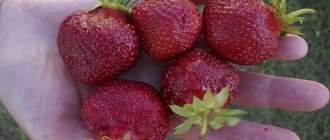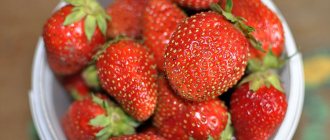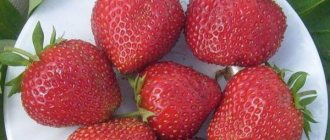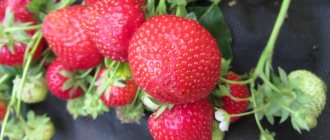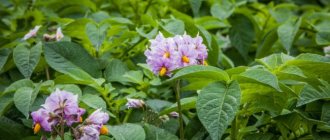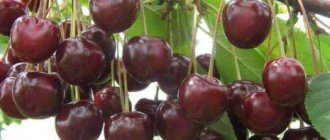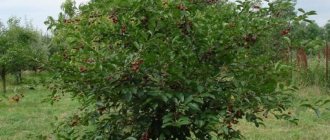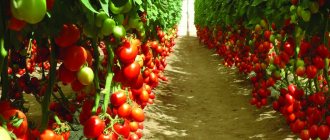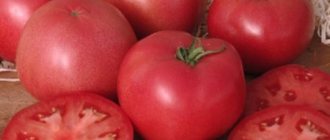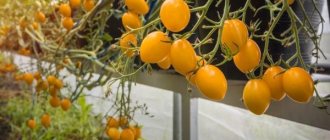Description
The mid-late strawberry variety Carmen is distinguished by its powerful bush structure, the splendor of which is given by wide leaves. Flowering begins in the second decade of June. At the end of the month, the first ovary is already formed. The berry has time to ripen during daylight hours.
The voluminous bushes of the Carmen variety are formed from many thin but very strong stems. The large leaf has large jagged edges. The color of the leaf blade is dark green. The surface is glossy.
Large saucer-shaped flowers are produced on thick, tall stems and are grouped in inflorescences. Peduncles are usually at the level of the foliage. Sometimes they can be located a little lower, but the leaf blades do not greatly shade the berries from the sun, allowing them to ripen.
The largest berries of the Carmen variety are harvested from the first wave of the harvest. The cone-shaped fruits weigh about 40 g. The ripe berry acquires a dark red color. When overripe, the fruits turn burgundy. The skin of the berry is glossy. The achenes are slightly pressed inward. The weight of the fruits of the second and subsequent harvests does not exceed 17 g.
The dense pulp is highly saturated with sweet juice. After eating the fruit, a slight sour taste is felt. The color of the pulp is dark red. The fruits of the Carmen garden strawberry variety can be transported and short-term stored in the refrigerator. The berries are frozen, processed, used to decorate baked goods, and eaten fresh.
Important! Due to its high, stable yield, the Carmen variety is suitable for commercial cultivation.
Advantages and disadvantages of the variety
The garden strawberry variety turned out to be quite successful. Culture has many positive qualities. The disadvantages are almost invisible against the background of the advantages.
| Positive traits | Negative qualities |
| Large fruits | Sprawling bushes require a lot of space |
| High stable yield | Decrease in berry weight of the second wave of harvest |
| The variety does not require special care | Rot damage in rainy summer |
| Winter hardiness of bushes | |
| Rapid establishment of seedlings |
Advantages and disadvantages
The strawberry variety Carmen has many clear advantages that almost completely cover its disadvantages. The main advantages include the large-fruited variety and high yield throughout the strawberry season. Carmen is also very easy to care for and can withstand low temperatures. The consistently high harvest of strawberries during this fruiting season makes this variety very popular for industrial and commercial purposes.
The disadvantages of the Carmen strawberry variety include: the need to allocate a large space for spreading bushes; after the first harvest, the berries of this variety decrease in weight; in the rainy season, strawberries are affected by rot.
Reproduction methods
Garden strawberry Carmen throws out powerful mustaches. All three methods of traditional propagation are suitable for this variety: by mustache, by seeds, by dividing the bush.
Usami
Engraftment of the mustache is done directly in the garden bed where the crop grows. After harvesting, the row spacing is cleared of weeds, the soil is loosened well, and the shoots are straightened from each bush. Each rosette on the cutting is slightly buried in the ground, after which it is watered. By autumn, the seedling of the Carmen variety will take root. The mustache is cut with scissors from the mother strawberry bush. A full-fledged seedling is transplanted to a new bed.
Dividing the bush
At the age of 2–4 years, adult bushes of Carmen garden strawberries are propagated by dividing the bush. This is done in the spring before flowering or in the fall after harvesting. The bush is dug out of the bed and divided with a knife or torn into several parts by hand. Each resulting seedling must have a strong rosette with at least three leaves and a developed root system. Plants are planted at the same depth as they grew when they were one bush.
Advice! It is better to propagate the Carmen variety by dividing the bush in cloudy weather. The planted seedlings are shaded until they are completely rooted.
Growing from seeds
To obtain Carmen garden strawberries from seeds, you need to grow seedlings. You can do this in two ways:
- in containers with soil;
- in pressed peat washers.
Attention! Read more about obtaining strawberry seedlings.
The main factor in obtaining good seedlings of the Carmen variety is adherence to technology, but first you need to obtain high-quality seeds. It is easier and better to buy them in a specialized nursery. If your favorite Carmen variety is already growing in the garden, the seeds are prepared from the berries. A ripe large fruit without rot on the skin is trimmed with a knife. The peelings with achenes are laid out on a plate and dried for about four days under the sun. Finished grains are sent for storage.
Before sowing, Carmen's own harvested garden strawberry grains are subjected to stratification. The seeds can be scattered on damp cotton wool, covered with plastic and placed in the refrigerator for 3-4 days. Many gardeners are accustomed to stratifying strawberry seeds simultaneously with sowing. Snow 2 cm thick is loaded on top into a container with soil or compressed peat tablets and the grains are laid out. The container is placed in the refrigerator. When the snow melts, the strawberry seeds themselves will sink into the soil or peat. The container is exposed to light in a warm place, awaiting germination.
The best time for sowing Carmen garden strawberries is considered to be the end of February - the beginning of April. During this period, daylight hours are still short. Strawberry seedlings are provided with artificial lighting.
The method of growing seedlings in pressed peat tablets is slightly different from the traditional method. The washers are placed in a plastic container and filled with warm water. After swelling, each tablet is squeezed out of excess water by hand, placed in an empty container, and 1-2 strawberry seeds are placed inside a special planting recess.
Important! The advantage of the method of growing strawberries in pressed peat discs is that there is no need to pick seedlings.
To grow strawberry seedlings in the soil, use separate containers or common containers. You can roll polyethylene foam into rolls with a layer of earth - snails.
If the Carmen garden strawberry seedlings grew in a common box, with the appearance of three leaves, the plants are planted in separate cups. Sowing should be done less frequently for ease of transplantation. Each plant is lifted with a spatula along with a lump of earth and transplanted into a cup. The method is called transshipment.
Important! Non-germination of seeds indicates their low quality or a violation of the technology for growing seedlings.
How to reproduce?
The "Carmen" variety can be propagated in several ways - by dividing the bush, by seeds and using stepsons. Since the crop is capable of throwing out tendrils, it can be implanted in the same bed where it grows. After harvesting, you should remove all weeds, carefully loosen the soil, straighten the strawberry shoots, and place the leaf rosettes formed on them in the top layer of soil and water them. By September or a little later, the shoots produce roots, and they can be separated by carefully cutting them from the mother bush. The resulting plant is a full-fledged seedling.
Another method is propagation by dividing the bush. It is suitable for adult two-year, three-year-old plants. This procedure can be performed twice - in the spring before the inflorescences appear or in the autumn, when the berries have already been collected. To do this, the bush is dug up and cut into three or four parts.
It is important that each rosette has at least three leaves and strong roots. They are usually planted in the evening or in the absence of sun, so that the leaves do not evaporate moisture, and then the plant is shaded until the root system is fully formed.
You can grow strawberries from seeds, of course, they must be of high quality. If the berry is already cultivated, then select the largest and ripest fruit and cut off its skin, which is then dried for 3-4 days in the sun. To increase the germination of seeds, they are stratified - they place the planting material on damp cotton wool, cover it with film and put it in the refrigerator for 4 days. It is better to sow in early April, providing additional lighting for the crop.
You can grow seedlings in boxes, containers with a nutrient substrate or special peat washers; in the latter case, the picking procedure will not be required in the future.
Landing
When seedlings of Carmen garden strawberries are purchased or have already grown from seeds, they need to be planted.
Attention! All the rules and details of the technology for growing strawberries in open ground.
How to choose seedlings
Good garden strawberry seedlings have bright green foliage. Plants are selected without stains or mechanical damage. The leaves must be whole and at least three pieces. Preference is given to plants with a horn thickness of 7 mm. When buying bare-rooted strawberry seedlings, look at their splendor and length, which should be at least 7 cm. If the plant is in a cup, the quality is determined by the lump of earth braided with roots.
Site selection and soil preparation
Garden strawberries Carmen likes to grow on flat areas. Slopes or hilly terrain are not suitable for the variety. Choose a site that is sunny, ventilated, but without drafts. When digging the beds, humus is added up to 1 bucket per 1 m2. If the soil is heavy, add sand. Areas with sandy and clay soil are doubly fertilized with organic matter.
Garden strawberries Carmen likes soil closer to neutral acidity. It is optimal to achieve indicators from 5.0 to 6.0. In case of increased acidity, dig up the soil in the garden bed with chalk or lime. Increased alkali is eliminated by adding peat or gypsum.
Planting scheme
Bushes of the Carmen variety are vigorous. It is not recommended to plant seedlings densely. It is optimal to maintain a distance of 30 cm between plants. Row spacing is about 45 cm. Dense planting of garden strawberries will lead to the proliferation of slugs, the occurrence of diseases, and the crushing of berries.
The video talks about the rules for planting strawberries:
Treatment of diseases and preventive measures
This species is quite resistant to most diseases characteristic of strawberry bushes. The exception is gray rot - berries are easily affected by it.
The disease spreads very quickly and in a short time can destroy a large number of not only fruits, but also entire bushes. Appears in conditions of high humidity and if plants are planted in a poorly lit and ventilated place.
Affected plants are treated completely with chemical solutions (Teldor, Horus, Switch, Alirin-B). There are also a number of folk remedies that help get rid of rot (infusion of ash, mustard, solution of manganese and iodine). Mulching is an excellent preventative method.
Care
The garden strawberry variety Carmen has the simplest growing technology. The plant needs regular watering, fertilizing, weeding and don’t forget to fight pests.
Care in spring
With the onset of spring, the beds are cleared of cover, damaged foliage on the bushes is cut off, and the soil is loosened. Strawberries are watered with warm water with 1 g of copper sulfate or manganese dissolved in 10 liters. To accelerate growth, apply nitrogen fertilizer, for example, saltpeter.
Watering and mulching
The plantation with garden strawberries is watered depending on the weather. The soil under the bushes should be slightly moist, but not swampy. With the appearance of buds and during the ovary of the berries, watering is increased more often. To prevent a film from forming on the soil, the bed is loosened. Mulch helps simplify maintenance. Sawdust, peat or straw retain moisture and slow down the growth of weeds.
Fertilizing by month
Strawberry fruits suck all the beneficial substances from the plant. To restore them, fertilizing with organic matter and mineral complexes is required.
Attention! Learn more about fertilizing strawberries.
Preparing for winter
The Carmen variety is considered winter-hardy, but for the winter the bushes require covering with straw mats, fallen leaves or pine branches.
Attention! Read more about wintering strawberries.
Description and characteristics of strawberries Carmen
The variety is very productive and is perfect for growing in garden plots. It is also cultivated for commercial sale in small areas.
The bushes are quite large and strong. The leaves are large and oval-shaped, with jagged edges. The flowers are collected in large inflorescences and arranged in such a way that they receive a sufficient amount of light.
The berries can be very large, they have the shape of a blunt cone. The pulp of the fruit is dark red in color, quite dense in consistency and sweet. The berry has a strong pleasant aroma.
Pests and ways to combat them
To prevent strawberries from being affected by spider mites, weevils, leaf beetles and other pests, preventive spraying with preparations is carried out. During the ripening of berries, the plantation is protected from birds by a mesh shelter.
Attention! Read more about strawberry pest control.
The video talks about methods of fighting slugs:
Treatment of garden strawberries from diseases and pests
Strawberries of this variety are highly resistant to most diseases. The exception is gray rot. Strawberries Carmen encounters this problem quite often. The disease is characterized by rapid development. It can cause damage to a large number of fruits and bushes in a short time. A prerequisite for the development of the disease is high humidity.
Affected bushes should be treated with chemicals. For this they use Horus, Teldor. Folk recipes are also used - infusion of ash or mustard. Also, Carmen's strawberries may suffer from attacks by harmful insects. The plant is often attacked by mites.
To cope with parasites, it is recommended to use Neoron or Fufanon.
Infection of a crop by a weevil leads to disruption of the flowering process. Spraying the bushes with insecticides will help cope with pests. An infusion of wood ash is also suitable. In this case, you should definitely get rid of the affected fragments.
See also
Description of the strawberry variety Cardinal, planting and cultivation
Read
When leaf beetles attack, the leaves of the plant are damaged. Insecticides help to cope with them. An infusion of wormwood is also used. Freshly slaked lime can help eliminate slugs. Nematode damage leads to the need to remove the bush.
Reviews
Carmen is one of my favorites: very productive and tasty. In all this time, I only encountered a problem once: several two-year-old varieties did not bear fruit. The bushes were powerful, the agricultural technology was usual, but there was no flowering. For the sake of experiment, I took a mustache from these bushes. The daughter plants did not show this unpleasant feature, and the next year they were already blooming and bearing fruit.
At the beginning of last year, of all the varieties of garden strawberries, I left only Asia and Carmen. At the end of the season, I will also remove Carmen. The bushes are beautiful, but there are few berries, it seems that all the strength of the plant goes to the tops.
Sources:
https://sortoved.ru/klubnika-zemlyanika/sort-klubniki-karmen.html https://frukti-yagodi.ru/opisanie-sorta-klubniki-karmen/ https://sort-klubnika.ru/sorta/klubnika -sort-karmen
Characteristics of the variety
Strawberries, or garden strawberries, of the "Carmen" variety have very powerful, vigorous, erect, densely leafy bushes with large, dark green leaves. There is a border of leaves with sharp teeth. Peduncles are quite thick. Compact inflorescences are formed, which are located at the level of the leaves or just below the foliage.
The berries of the first harvest are very large, weighing at least 38-40 g, blunt-conical in shape, dark red in color, shiny and beautiful. The average weight of a mass-harvested berry is about 15-17 g. The berry pulp is dark red, juicy and relatively dense, with a good sweet and sour taste. Productivity is stable and high.

